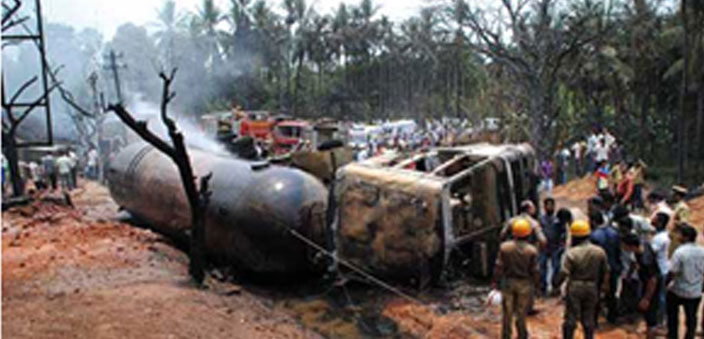Road Safety is an issue of national concern, considering its magnitude, gravity and consequent negative impacts on the economy, public health and the general welfare of the people. India is home to the largest number of road fatalities in the world. According to the National Crime Records Bureau of the Government of India, 1,41,526 persons died and 4, 77,731 persons were injured during the year 2014, involving 4,50,898 road accidents. Hundreds of road accidents involving hazardous materials were reported from different parts of India every year.
The tragic case studies
A Natural gasoline tanker accident on the Western Express Highway in Mumbai in 1991: Although about 25 years have elapsed, the case of a road accident, which occurred on the Western Express Highway in Mumbai towards the end of 1991, is still in the memory of many and it was a classic example how ignorance can lead to a gruesome disaster, in which 67 people perished. In this accident, a tanker which was transporting natural gasoline liquid, overturned, and the material started leaking heavily. The general public (mostly tribal), living in the hamlets near the road ignored the plea of the driver/cleaner and started collecting the liquid. Somebody might have thrown a lighted matchstick inadvertently, and the liquid caught fire.
Explosion due to collision of a tourist bus and an acid tanker in Goa on 16th January, 2008: At least 12 people, including 10 non-resident Indians (NRIs) from Britain and France, were charred to death and 10 other people seriously burnt in Goa when the tourist bus in which they were travelling collided with a tanker filled with acid, leading to an explosion and fire.
The gruesome accident involved four vehicles, including the tourist bus carrying 22 people, the tanker carrying acid, and a goods truck.
An LPG Bullet Tanker caught fire at Perne, Karnataka on 9th April 2013: Six persons were killed on the spot and four injured when a bullet tanker carrying liquefied petroleum gas overturned and the gas leaking from it caught fire at Perne on Mangalore-Bangalore National Highway. The accident occurred, when the tanker driver lost control while negotiating a sharp bend. While the gas from the tanker leaked and caught fire, three LPG cylinders kept in a godown nearby also exploded due to the heat generated.
Oil tanker explosion on Mumbai-Ahmedabad Highway on 23rd March 2014: Seven people were charred to death on the spot while 13 others were injured in an Oil Tanker explosion on the Mumbai–Ahmedabad Highway.
The oil tanker went up in flames in Dahanu‘s Charotanaka. The leaping flames from the burning vehicle also gutted a portion of a hotel, located nearby.
An ammonia tanker skid off Mumbra Bypass Road, Thane, on 24th May 2015: A tanker carrying compressed liquid ammonia skid off the Mumbra bypass road and toppled, releasing large amounts of ammonia. The driver lost control of the tanker while taking a turn on a narrow road to avoid collision with an incoming truck and fell in to a 14-feet deep gutter. The tanker was carrying 14,850 kgs of ammonia. As No one was hurt. Fortunately, the gas did not spread.
Statistics of road transportation accidents in India
Experience reveals that as not all injuries are reported to the police, the actual numbers of injuries requiring hospital visits may be as high as two to three million people. The situation in India is worsening, and road traffic injuries have been increasing over the past 20 years. This may be partly due to the increase in number of vehicles on the road, but mainly due to the absence of a coordinated evidence–based policy to control the problem. The data shows that the number of fatalities has continued to increase at about seven per cent a year over the past decade except over thelast couple of years. If the estimate of road traffic fatalities in India (official) in the year 2014 is taken as 141,526, then the estimate of serious injuries requiring hospitalisation would be 2122,890.

Preventing accidents
The consequences of road accidents are much more serious when the vehicle is loaded with hazardous goods. Hazardous goods pose a potential danger to life and property. Major road accidents have clearly demonstrated that hazardous chemical carriers, when involved in accidents, cause disastrous consequences like fire, explosion and spillage, resulting in loss of life and property, besides environmental pollution. Such accidents demand immediate availability of essential information to take appropriate counter measures. Thus, there is great scope for improving safety in transportation in general and transportation of hazardous goods in particular. Besides the poor infrastructure, poor enforcement of provision of Central Motor Vehicle Rules and other applicable rules and regulation, lack of awareness about the dangers of hazardous chemicals and what to do in an emergency, is also a matter of concern. The quality of professional drivers is very poor. These drivers hardly have any educational qualification or specialised training. They come from very poor families and are held in very low esteem in society.
Incidentally, statistics reveal that in India, drivers are responsible for more than the 70 % of the road accidents involved in vehicles. Hence we must pay much more attention in improving the quality of drivers.
With this in view, the Kalyan Ambernath Manufacturer Association (KAMA), NSC-Action Centre, has undertaken the task of promoting safety in transportation by increasing the competency level of the drivers and making them aware of the hazardous nature of the goods and the safety measures to be undertaken. Emphasis is given on making the drivers aware, in case of accidents, on how to warn the general public about the dangers associated with the goods, and make them take care of their personal safety. During the training programmes, stress is also given on display and interpretation of emergency information panel board on vehicles. They are also made familiar with the various statues concerning them, the transporters and the consigners as stated in Centre Motor Vehicles Rules 1989.
KAMA conducts such training programmes for drivers (as per the three-day syllabus mentioned in the Central Motor Vehicles Rules, 1989). For trained drivers,a one-day refresher training programme is conducted, succeeding which, a certificate is issued for one year which is endorsed by the RTO (Regional Transport Office). This certificate entitles the driver to carry hazardous goods on road. These training programmes are conducted at regular intervals at Century Chemicals, Kalyan, on Sundays, once in two months. Till date, KAMA has conducted 81 batches covering 5,151 drivers.
Conclusion
India has a number of statutes relating to the transport of hazardous chemicals. The transport of hazardous chemicals by road is very popular in India and the vehicles used include pressurised tankers, trucks trailers etc. Amongst the statutes, the Central Motor Vehicles Rules are the most important. There are elaborate rules regarding the transport of hazardous chemicals. However, these rules are not strictly complied by some consigners, transporters and drivers. It means that these groups are either deliberately ignoring the safety provisions in CMV and other related rules, or carry out their activities due to ignorance or lack of awareness. In any case, it calls for strict enforcement of rules relating to the transport of hazardous chemicals and also calls for actions to create/increase awareness amongst consigners, transporters and drivers.
The real pressure and motivation to improve driving skills can come only through licensing authorities, by adopting stricter, more comprehensive and scientifically based tests, laying stress on road rules and regulation and traffic control devices. In addition to this, recognised institutions can further add to increase the competency level of these drivers by imparting training on the precautions to be taken during loading, unloading, and transportation of hazardous goods and make them aware of handling the situation in case of emergencies, in order to save life, property and environmental degradation.


 [/column]
[/column]